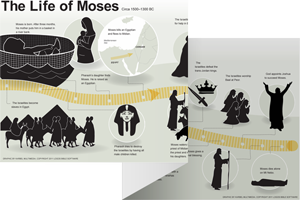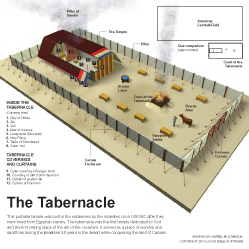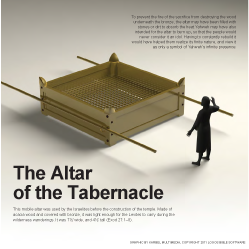1:1–2 The book of Leviticus |
1:1 Yahweh The proper name of the God of Israel is yhwh. These four letters are sometimes called the Tetragrammaton. God revealed His name to Moses at the burning bush (see Exod 3:14 and note).
God revealed His name to Moses at the burning bush (see Exod 3:14 and note).
Moses The intermediary between Yahweh and Israel who receives the law at Sinai (see note on Exod 2:10).
Moses was commissioned by Yahweh to lead His people out of Egypt and bring them to Canaan, the land that Yahweh had promised to Abraham (see Gen 12:5–7; Exod 1–15). Moses is the central figure in the exodus |
the tent of assembly The Hebrew phrase used here, ohel mo’ed (often translated “tent of meeting”), regularly refers to the entire tabernacle complex at the center of the Israelite camp (e.g., Num 2:2, 17). The actual tent of meeting is the tent shrine itself within the tabernacle complex (see Lev 4:4–7).
regularly refers to the entire tabernacle complex at the center of the Israelite camp (e.g., Num 2:2, 17). The actual tent of meeting is the tent shrine itself within the tabernacle complex (see Lev 4:4–7).
1:2 presents an offering to Yahweh The Hebrew word used here, gorban—often translated “offering” and literally rendered as “gift”—refers generally to anything presented to God
word used here, gorban—often translated “offering” and literally rendered as “gift”—refers generally to anything presented to God when approaching Him. In the book of Leviticus, the term usually indicates a sacrifice.
when approaching Him. In the book of Leviticus, the term usually indicates a sacrifice. Sacrifices were brought as gifts to God; they were gestures of thankfulness and worship. Israelites also sacrificed for the purposes of atonement for sin or restoration of ritual purity.
Sacrifices were brought as gifts to God; they were gestures of thankfulness and worship. Israelites also sacrificed for the purposes of atonement for sin or restoration of ritual purity.
domestic animals Only domesticated animals were acceptable sacrifices because the offering was meant to be costly for the worshiper (compare 2 Sam 24:24). Wild animals, even those acceptable for consumption, were not allowed as sacrificial animals (see Deut 14:4–5).
1:3–17 The first type of sacrifice is called the olah in Hebrew—this is often rendered as “burnt offering.” The sacrificial animal could be a bull, a ram, a male goat, a turtledove, or a pigeon. The procedures for offering the sacrifices are very similar; the only changes regard the birds, since they are smaller animals. Despite the similarity, many of the details are repeated almost verbatim. For example, the rules are given for handling the bull in Lev 1:3–9, and then the same rules are given for handling the sheep or goat in vv. 10–13. The burnt offering (an olah) was the most costly type of sacrifice since the entire animal carcass was burned on the altar. It would also have been the most common type of sacrifice. A burnt offering was to be offered every morning and evening (Exod 29:38–42). |
1:3 a burnt offering An offering where the whole sacrificial animal was burned on the altar (Exod 27:1–8). See note on Lev 6:9.
was burned on the altar (Exod 27:1–8). See note on Lev 6:9.
 Types of Offerings in the Old Testament Table
Types of Offerings in the Old Testament Table
male The sacrificial animal could be male or female, depending on the type of sacrifice. Burnt offerings had to be male animals.
an unblemished The Hebrew adjective used here, tamim, refers to something complete and unblemished. A sacrificial animal had to be without physical defect of any kind. See Exod 12:5 and note.
the door of the tent of assembly Refers to the open area outside and in front of the tent shrine in the tabernacle. This open area is also called the “courtyard of the tabernacle” (chatsar hammishkan; see Exod 27:9). This was the area accessible to laypeople, where they carried out their responsibilities for the sacrificial ritual.
his acceptance The desired outcome of the sacrifice is God’s acceptance (ratson) of the worshiper. Acceptance means God has a favorable disposition toward the person. Failure to properly observe the sacrificial procedures could result in the sacrifice not being accepted (see Lev 7:18). Rote observance of the rituals also did not guarantee acceptance if the people drifted away from God (see Jer 14:12; Amos 5:22).
1:4 He must lay his hand on the head of the burnt offering A symbolic act that acknowledged the relationship between the worshiper and the sacrificial offering. The significance of the symbolism is uncertain. One possibility is that it indicated ownership. Another interpretation is that the laying on of hands indicated substitution—the animal took the place of the person. Alternately, the act may have symbolized the transfer of sin and guilt from the worshiper to the animal, which would die in the bringer’s place to atone for sin.
make atonement The Hebrew verb for making atonement is kipper, but the basis of that meaning is unclear. Making atonement (kipper) may allude to sin or guilt being wiped away, but it could also indicate the sin is covered over. Alternately, kipper may describe paying a ransom or otherwise making amends for wrongdoing. See note on Lev 4:20.
is kipper, but the basis of that meaning is unclear. Making atonement (kipper) may allude to sin or guilt being wiped away, but it could also indicate the sin is covered over. Alternately, kipper may describe paying a ransom or otherwise making amends for wrongdoing. See note on Lev 4:20.
1:5 He must slaughter the young bull The person bringing the offering slaughtered their own sacrifice. The sacrificial ritual had a clear division of labor between what the worshiper was responsible for and what the priests were responsible for.
before Yahweh The burnt offering was slaughtered liphne yhwh, meaning “before” or “in the presence of” Yahweh. The precise location is unspecified, but the entire ritual took place at the entrance of the tent of meeting (v. 3). According to v. 11, the slaughter took place on the north side of the altar.
Aaron’s sons, the priests The priest was responsible for handling the animal’s blood and for placing the pieces on the altar.
 Functions of Priests Table
Functions of Priests Table
sprinkle the blood Sacrificial rituals involved various actions that were to be done with the blood, often sprinkling or pouring the blood on or around the altar (see Exod 29:16–20).
often sprinkling or pouring the blood on or around the altar (see Exod 29:16–20).
altar Refers to the altar of burnt offering, the large bronze altar in the courtyard of the tabernacle (Exod 27:1–8). The courtyard is here called the “entrance of the tent of meeting” (see note on Lev 1:3).
of burnt offering, the large bronze altar in the courtyard of the tabernacle (Exod 27:1–8). The courtyard is here called the “entrance of the tent of meeting” (see note on Lev 1:3).
1:6 cut it into its pieces The worshiper was generally responsible for skinning the animal and cutting it into pieces that would be placed on the altar. For public sacrifices, the priests and Levites would do the work of flaying and cutting (see 2 Chr 35:10–11). For a burnt offering, the hide was not burned but was given to the priest who officiated over the sacrifice (see Lev 7:8).
1:7 fire on the altar and arrange the wood The priests were responsible for the altar. Only they were supposed to put or arrange anything on the altar. Anyone who approached the altar who was not a priest was subject to the death penalty (Num 18:7).
1:8 will arrange the pieces The sacrifice was placed on the altar in stages. The first stage included the animal’s head, all the fat, and the cut-up pieces (except for the hind legs).
1:9 he must wash its inner parts and its lower leg bones with water While the priest placed most of the sacrifice on the altar, the worshiper had to wash the animal’s hind legs and its entrails, probably to remove the dung (compare Lev 4:11).
will turn into smoke the whole This verb for burning the sacrifice comes from a Hebrew noun meaning “smoke.” Thus, this phrase can be literally translated as “turn the whole (thing) into smoke.”
food offering The Hebrew term used here, isheh, is commonly associated with the noun esh, meaning “fire.” This results in the translation of “offering by fire.” However, the meaning of isheh is could be related to cognate terms for “gift” in Arabic ('aṯṯa) and Ugaritic ('iṯṯ). Since the translation “offering by fire” is also difficult to support from the general usage of isheh in the ot, the word most likely refers to some kind of gift and should probably be understood as referring to a food gift or food offering.
('iṯṯ). Since the translation “offering by fire” is also difficult to support from the general usage of isheh in the ot, the word most likely refers to some kind of gift and should probably be understood as referring to a food gift or food offering.
an appeasing fragrance The Hebrew phrase used here, reach nichoach, expresses the intended outcome of the sacrifice. The smoke rises up to Yahweh, carrying a smell that satisfies and pleases Him. The word reach means “smell,” “odor,” or “fragrance.” The noun nichoach is typically understood as either “soothing” or “pleasing.” The distinction over whether the aroma pleases or appeases Yahweh is significant. Something pleasing Yahweh is much different from something appeasing Him. A delight brings enjoyment and pleasure (without reference to wrath). Appeasement refers to allaying His wrath (compare Gen 8:21; Lev 26:31). The phrase is used for most offerings burned on the altar, including the burnt offering (see vv. 9, 13, 17), the grain offering (see 2:2, 9, 12), the peace offering (see 3:5, 16), and the sin offering (see 4:31).
1:10 from the flock A male sheep or goat could also be presented for a burnt offering. The procedures for handling the sacrifice are the same as outlined for the bull. See note on vv. 3–17.
1:11 the north side of the altar The main difference between the guidelines for the bull and those for a ram or goat is the explicit statement that the flock animal was slaughtered on the north side of the altar. The bull was slaughtered “before Yahweh” (see v. 5 and note). Either this statement was added to make explicit that the ram or goat should be slaughtered in a specific location—north of the altar, different from where the bull was slaughtered—or the text is adding to the information from v. 5, namely that the place of slaughter “before Yahweh” was north of the altar.
1:14 birds The last option for an acceptable burnt offering was a bird, specifically a dove or a pigeon. These birds were apparently domesticated in ancient Israel (see Isa 60:8).
1:15 must wring off its head Or “pinch off” the head. The verb is only used one other time—in Lev 5:8, where the bird’s head is to be pinched off at the neck but not severed completely. Due to their small size, birds were not cut in pieces (v. 17).
blood will be drained out For the larger animals, the blood was to be sprinkled all around the altar. For the bird (with a smaller quantity of blood), the priest merely drained the blood against the side of the altar.
1:16 crop The Hebrew word used here, mur'ah, appears in the ot only this once, but it is generally understood to refer to the bird’s crop or craw.
plumage The meaning of the Hebrew term used here, notsah, is uncertain. Elsewhere it seems to indicate a bird’s feathers or plumage (see Ezek 17:3). Here the context suggests notsah is possibly the contents of the crop.
the place of the fatty ashes The crop and contents (or plumage) was not offered on the altar. It was discarded along with the ashes that were removed from the altar every morning (Lev 6:8–13).

|
About Faithlife Study BibleFaithlife Study Bible (FSB) is your guide to the ancient world of the Old and New Testaments, with study notes and articles that draw from a wide range of academic research. FSB helps you learn how to think about interpretation methods and issues so that you can gain a deeper understanding of the text. |
| Copyright |
Copyright 2012 Logos Bible Software. |
| Support Info | fsb |
 Loading…
Loading…


 Moses
Moses 

